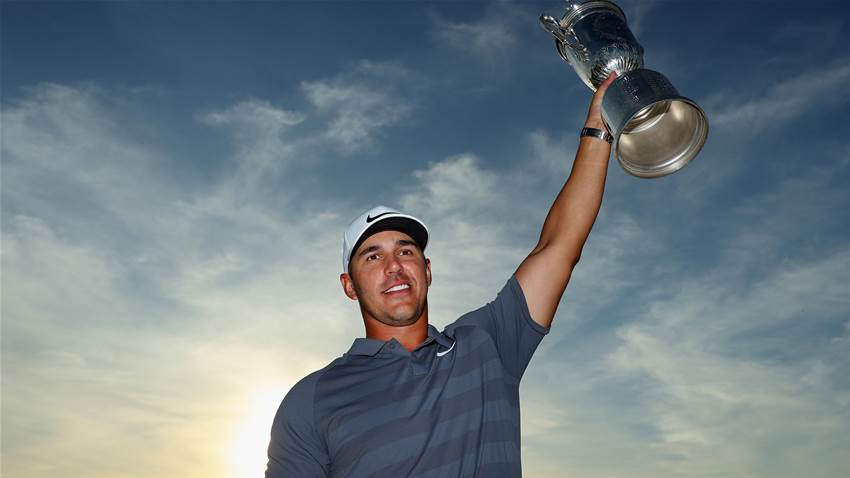Will the 2018 US Open be remembered for Brooks Koepka’s terrific play, or the latest chapter in USGA course set-up incompetence?
Make no bones about it, Brooks Koepka played brilliant golf to win his second US Open title in as many starts. He drove the ball long, and pretty straight, but it was on the greens where he poked his nose in front of the field.
His clutch putting – on the most ridiculously quick putting surfaces seen since the 2004 US Open at Shinnecock Hills – was sublime. The 15-footer to save bogey on the 11th hole in the final round will be a moment Koepka will look back upon as crucial to his victory.
It is unfortunate that memories of Koepka’s remarkable victory – like Retief Goosen’s in 2004, like Jordan Spieth’s in 2015 and, to some degree, Dustin Johnson’s in 2016 – will be hijacked by the seemingly incompetent United States Golf Association. In all four of these championships, the USGA lost control of the course as it tried to manipulate what the final score would be. It’s no secret, the desire of the USGA is to have a winning score within a few strokes either side of even par.
And so it is every year when the US Open rolls around, we learn how the USGA has ‘tampered’ with the original design and/or set-up of the course to “make it the toughest challenge in golf” – a mantra that I am sure is stitched into the lining of every blue blazer handed out to the USGA executive.

This year, we learned the USGA, in prepping Shinnecock Hills, reclaimed seven acres of 50 acres of fairway to plant long fescue grass. The wide fairways – a key attribute of the extensive Bill Coore-Ben Crenshaw redesign of 2012 – were narrowed down, eliminating many of the angles and playing lines the designers had envisioned players would take to hit into the corners of the putting surfaces.
It’s no secret, the desire of the USGA is to have a winning score within a few strokes either side of even par.
With fewer playing lines available to all players – that is short and long hitters – the ‘US Open Doctored’ course removed the shorter hitter (any player averaging drives less than 295 yards) from any discussion about who might win. Against the power-hitting might of a Koepka or Dustin Johnson, the shorter player at Shinnecock, who was using a 5-iron against a Koepka or Johnson 8-iron, had little to no chance.
But that’s the path the USGA has taken. Have a look at the past four US Opens and the leader of the driving distance stats has won three titles and finished second in the other.
To compound the problem, the USGA lost the golf course midway through the third round – just as it promised it would never do again after the 2004 final round at Shinnecock when greens had to be watered between groups.

But USGA CEO Mike Davis was forced to apologise for Saturday’s course set-up after a number of players branded Shinnecock “unplayable”, “not a fair test of golf” and accused the organisation of crossing the line with pin positions, knowing the greens would be quick and the wind strong.
“There’s a long history of the US Open being a tough test of golf. We want it to be a complete test of golf,” Davis said after the third round. “Today, what we saw was a tale of two golf courses from the morning to the afternoon. All the members from the team that set the course up felt good about where things were when we left the 18th green this morning.
“But the fact of the matter is it got too tough on us in some areas. By that I mean … we really want to test execution, what we don’t want to see is well-executed shots are not only not rewarded but, in some cases, are penalised. We saw a few examples of that today and that’s not what we wanted.
“When you cut to the chase, we got more wind than we bargained for and the greens dried right out. When these greens dry out they shrink.”

The one question not asked of Davis was, “knowing there was some wind coming, why run the risk of losing control by cutting the greens?”
Having the greens running faster and faster, pushing greens to the edge of survival, is another USGA US Open initiative in the name of producing “the toughest test of golf” and combating the long distances players hit the ball.
But when you adopt this speedy initiative on greens created in the Golden Era of design, when green speeds were half of what they are now, you are simply asking for trouble. The R&A lost a full day’s play at The Open in 2015 because the wind was too strong and balls were moving on the greens of the Old Course. The Old Course was the only course in Scotland’s Kingdom of Fife where no golf was played that day.

The US Open heads to Pebble Beach in 2019 where Koepka will aim to become the first player since Willie Anderson in 1905 to win the trophy in three consecutive years. And we can only hope for his sake and his legacy, that the USGA leaves the bloody course alone.
WHAT THE PLAYERS SAID AFTER ROUND 3
“We’re not on the edge. I thought we could be on the edge but we’ve surpassed it, and now it’s pretty much gone.” – Zach Johnson
“It’s not that the entire course is unplayable but a couple pins are unnecessary.” – Justin Thomas.
“I don’t have anything nice to say about that green and the pin location, so I’m just not going to say it.” – Brooks Koepka.
“(The USGA) need to get people who know what they’re doing and set up the golf course right.” – Marc Leishman.
“I’m not sure I could possibly comment without using words which shouldn’t be seen ... just like some of those pins.” – Ian Poulter on Twitter
“As a player and a golf fan myself, it’s sad to see how one of our biggest tournaments @usopengolf gets ripped apart because the @USGA can’t figure out the right set up for the great golf courses we play!!” – Sergio Garcia on Twitter.
Related Articles

Smith out on course first as Aussie nine targets Open challenge

Feature Story: Oakmont Unleashed













